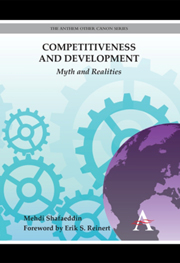Book contents
- Frontmatter
- Contents
- List of Tables, Figures and Boxes
- Foreword
- Preface
- Acknowledgements
- List of Abbreviations
- 1 Introduction: Framework of Analysis
- 2 Context and Conditions of International Competition
- 3 Alternative Theories of Competitiveness
- 4 Firm Strategy and New Industrial Organization
- 5 External Economies: Organization of Interfirm Relations
- 6 Reputation and Trust: A Firm's Relations with Stakeholders and Others
- 7 Innovation and Upgrading
- 8 Government Policies
- 9 The Experiences of China and Mexico
- 10 Summary and Concluding Remarks
- Appendices
- Bibliography
- Index
Appendices
Published online by Cambridge University Press: 05 February 2013
- Frontmatter
- Contents
- List of Tables, Figures and Boxes
- Foreword
- Preface
- Acknowledgements
- List of Abbreviations
- 1 Introduction: Framework of Analysis
- 2 Context and Conditions of International Competition
- 3 Alternative Theories of Competitiveness
- 4 Firm Strategy and New Industrial Organization
- 5 External Economies: Organization of Interfirm Relations
- 6 Reputation and Trust: A Firm's Relations with Stakeholders and Others
- 7 Innovation and Upgrading
- 8 Government Policies
- 9 The Experiences of China and Mexico
- 10 Summary and Concluding Remarks
- Appendices
- Bibliography
- Index
Summary
Main GATT/WTO Agreements
GATT came into force in January 1948 as an interim multilateral agreement after the USA congress failed to ratify the agreement on the creation of ITO (International Trade Organization) and the Havana Charter. In practice GATT turned into a framework for the international trade system. Since then there have been eight rounds of trade negotiations (five in the 1950s and 1960s, the Tokyo Round of 1973–9, the Uruguay Round (UR) of 1986–94 and the latest Doha Round, which started in 2000 but has not yet been concluded. The UR led to the establishment of the WTO and a comprehensive agreement on international trade rules and some related issues.
The UR agreements consist of 13 agreements on goods covering: (1) the General Agreement on Tariffs and Trade 1994, which is basically GATT 1947 and its amendment during various rounds, as well as 6 ‘understandings’ which provide interpretation of some of the articles of GATT; (2) 12 other agreements on goods dealing with agriculture, textiles and clothing, health and safety issues, antidumping procedures, custom valuation, perishable inspection, rules of origin, import licensing, subsidies and countervailing measures, safeguards and TRIMs (Trade Related Investment) issues; (3) it also includes such other agreements as GATS (General Agreement on Trade in Services); TRIPs (Trade-Related Aspects of Intellectual Property Rights); (4) understanding on dispute settlements; and four plurilateral trade agreements concerning civil aircraft, government procurement, dairy products and bovine meat.
- Type
- Chapter
- Information
- Competitiveness and DevelopmentMyth and Realities, pp. 275 - 282Publisher: Anthem PressPrint publication year: 2012



